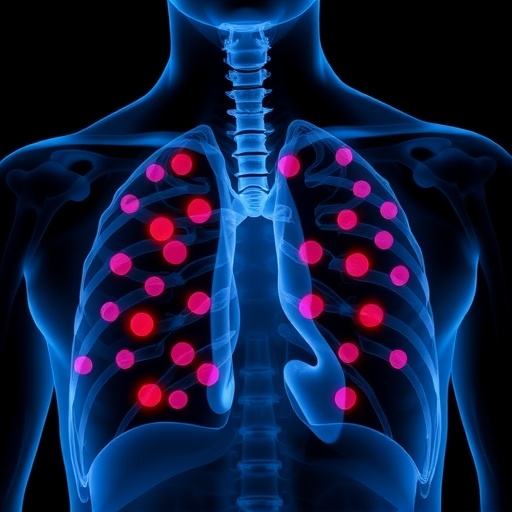Acute lung injury (ALI) remains a formidable clinical challenge, characterized by rapid-onset respiratory failure and high mortality rates globally. Recent advancements have begun to unravel the intricate cellular and molecular mechanisms that drive this debilitating syndrome. A groundbreaking study led by Zhang and colleagues has unveiled a novel therapeutic pathway involving the sedative agent dexmedetomidine (Dex), transcending its traditional use to reveal potent protective effects in the setting of lipopolysaccharide (LPS)-induced ALI. This discovery not only advances our understanding of ALI pathophysiology but also opens new avenues for treatment strategies centered on immunomodulation and autophagy.
In this pivotal research, the authors utilized a robust murine model of LPS-induced ALI to meticulously investigate the impact of Dex pretreatment on the progression and severity of lung injury. LPS, a bacterial endotoxin, is notorious for triggering intense pulmonary inflammation and oxidative stress, leading to compromised lung function. The study focused on key indicators of ALI such as pulmonary histopathology, cell apoptosis, and the dynamics of macrophage populations within the bronchoalveolar lavage fluid (BALF). Here, macrophage polarization states — particularly the balance between pro-inflammatory M1 and anti-inflammatory M2 phenotypes — emerged as critical determinants of the injury and repair process.
One of the most compelling findings of this study was the ability of Dex to revive autophagic flux in alveolar macrophages, a process severely disrupted by LPS exposure. Autophagy, a catabolic mechanism for degrading dysfunctional cellular components, plays a crucial role in maintaining cellular homeostasis during stress. LPS-mediated blockade of autophagy is implicated in exacerbating inflammatory responses and cell death. Dex’s restoration of autophagic activity was evidenced by modulation of key markers such as LC3 and P62, reflecting a more functional degradation pathway that aids in resolving inflammation and cellular damage. This effect alone positions Dex as a promising candidate for modulating innate immune responses in ALI.
Delving deeper into the molecular underpinnings, the researchers uncovered a significant upregulation of aconitate decarboxylase 1 (ACOD1) and hypoxia-inducible factor 1-alpha (HIF-1α) in response to LPS insult, both molecules intricately linked to the metabolic and inflammatory circuitry of macrophages. Remarkably, Dex further amplified the expression of these proteins, suggesting a synergistic mechanism whereby Dex harnesses the HIF-1α/ACOD1 axis to promote beneficial macrophage autophagy and drive an anti-inflammatory M2 polarization state. This polarization is essential for tissue repair and the attenuation of excessive inflammation—a hallmark of ALI progression.
Mechanistically, the interplay between HIF-1α and ACOD1 was dissected through rigorous in vitro experiments using RAW264.7 macrophages, where gene silencing techniques (siRNA against ACOD1 and HIF-1α) demonstrated that ACOD1 expression is transcriptionally regulated by HIF-1α. This regulatory cascade underscores the adaptive response of macrophages in hypoxic and inflammatory environments, modulated by Dex to favor resolution over injury propagation. These insights into gene regulation deepen the current understanding of macrophage plasticity in inflammatory lung diseases.
The therapeutic relevance of these findings was further reinforced by co-culture experiments involving mouse pulmonary microvascular endothelial cells (MPMVECs). ALI often involves endothelial injury leading to vascular leakage and edema. The study showed that Dex treatment mitigated endothelial damage induced by LPS-stimulated macrophages, highlighting a paracrine effect where modulated macrophage phenotypes exert protective influence on neighboring vascular cells. This intercellular crosstalk orchestrated by Dex broadens the spectrum of its lung-protective capabilities and may mitigate complications such as pulmonary edema.
Another significant contribution of the study is the comprehensive profiling of macrophage populations within BALF. In ALI, an influx of inflammatory M1 macrophages perpetuates tissue damage, while M2 macrophages facilitate repair. Dex skewed this balance towards the M2 phenotype, an effect corroborated by increased arginase-1 (Arg-1) expression and diminished inducible nitric oxide synthase (iNOS) levels. These markers illustrate the phenotypic switch driven by the HIF-1α/ACOD1-autophagy pathway, positioning Dex as a modulator of immune cell fate decisions in inflamed lung tissue.
Histopathological analyses reinforced these molecular insights, revealing reduced alveolar septal thickening, diminished inflammatory infiltrates, and less epithelial cell apoptosis in Dex-treated mice. These structural improvements translate into better lung compliance and gas exchange, addressing the functional deficits that plague ALI patients. Importantly, Dex’s ability to maintain pulmonary architecture under septic challenge speaks to its potential role in clinical scenarios characterized by systemic inflammation and multi-organ dysfunction.
This study heralds a paradigm shift in our approach to ALI management, suggesting that leveraging pharmacological agents to enhance macrophage autophagy and promote resolution-phase immune responses can dramatically alter disease trajectory. Dexmedetomidine’s repositioning from a mere anesthetic adjunct to an immunomodulatory agent with direct cellular protective properties underscores the untapped therapeutic potential lying within existing drugs. Such findings prompt a reevaluation of Dex in critical care and pulmonary medicine frameworks.
Equally striking is the use of advanced molecular tools such as siRNA-mediated gene knockdown and sophisticated fluorescence microscopy to validate intricate signaling networks. This methodological rigor not only substantiates the biological plausibility of the HIF-1α/ACOD1 axis as a target but also provides a template for future studies aiming to decode complex immune responses in pulmonary disease. By integrating in vivo and in vitro data, the researchers present a compelling narrative of cross-scale biological interplay.
The study also aligns with a growing body of literature that highlights hypoxia signaling, particularly via HIF-1α, as a central regulator of inflammation and metabolism in immune cells. Hypoxic microenvironments, common in injured tissues, drive macrophage reprogramming that shapes healing processes. Dex’s capacity to boost HIF-1α activity situates it within this emerging framework, suggesting that therapeutic manipulation of oxygen-sensing pathways could have broad applications beyond ALI.
From a clinical translation perspective, these findings invite urgent exploration through controlled human trials to evaluate Dex’s efficacy and safety profile in patients with acute respiratory distress syndromes. Current supportive care options for ALI remain limited, and pharmacological modulation of macrophage function represents a promising frontier. Moreover, understanding the dosage and timing of Dex administration will be critical to maximize therapeutic benefits while mitigating potential side effects.
The implications of this research extend beyond ALI to other inflammatory and hypoxia-driven diseases, including chronic obstructive pulmonary disease (COPD), pulmonary fibrosis, and sepsis. The modulation of macrophage autophagy and polarization pathways may serve as a universal strategy for controlling pathological inflammation across organ systems. As our understanding of immune metabolism deepens, interventions like Dex that target metabolic sensors and transcriptional regulators could revolutionize treatment paradigms.
In summary, this landmark study elucidates a transformative mechanism by which dexmedetomidine alleviates LPS-induced acute lung injury. By harnessing the HIF-1α-mediated transcriptional activation of ACOD1, Dex promotes macrophage autophagy and encourages a reparative M2 polarization phenotype, culminating in reduced inflammation and enhanced tissue preservation. These insights not only expand the therapeutic arsenal against ALI but also pave the way for novel immunometabolic interventions in critical illness.
The compelling evidence presented by Zhang et al. positions dexmedetomidine as a multifunctional agent capable of orchestrating complex cellular responses that counteract the devastating consequences of acute lung injury. As research unfolds, the convergence of autophagy, hypoxia signaling, and immune polarization illuminated by this work promises to redefine how clinicians comprehend and combat inflammatory lung diseases.
Subject of Research:
Mechanisms by which dexmedetomidine alleviates LPS-induced acute lung injury through modulation of macrophage autophagy and polarization.
Article Title:
Dexmedetomidine relieves LPS-induced acute lung injury by boosting HIF-1α/ACOD1 driven anti-inflammatory macrophage polarization.
Article References:
Zhang, N., Chen, T., Chang, Y. et al. Dexmedetomidine relieves LPS-induced acute lung injury by boosting HIF-1a/ACOD1 driven anti-inflammatory macrophage polarization. Genes Immun (2025). https://doi.org/10.1038/s41435-025-00355-1
Image Credits:
AI Generated
DOI:
https://doi.org/10.1038/s41435-025-00355-1
Tags: cellular mechanisms of acute lung injurydexmedetomidine and autophagyDexmedetomidine for acute lung injuryimmunomodulation in respiratory failureLPS-induced lung inflammationmacrophage polarization in lung diseasemurine models of lung injurynovel treatments for respiratory conditionspro-inflammatory M1 and anti-inflammatory M2 macrophagespulmonary histopathology and cell apoptosissedative agents in lung protectiontherapeutic pathways for lung injury





